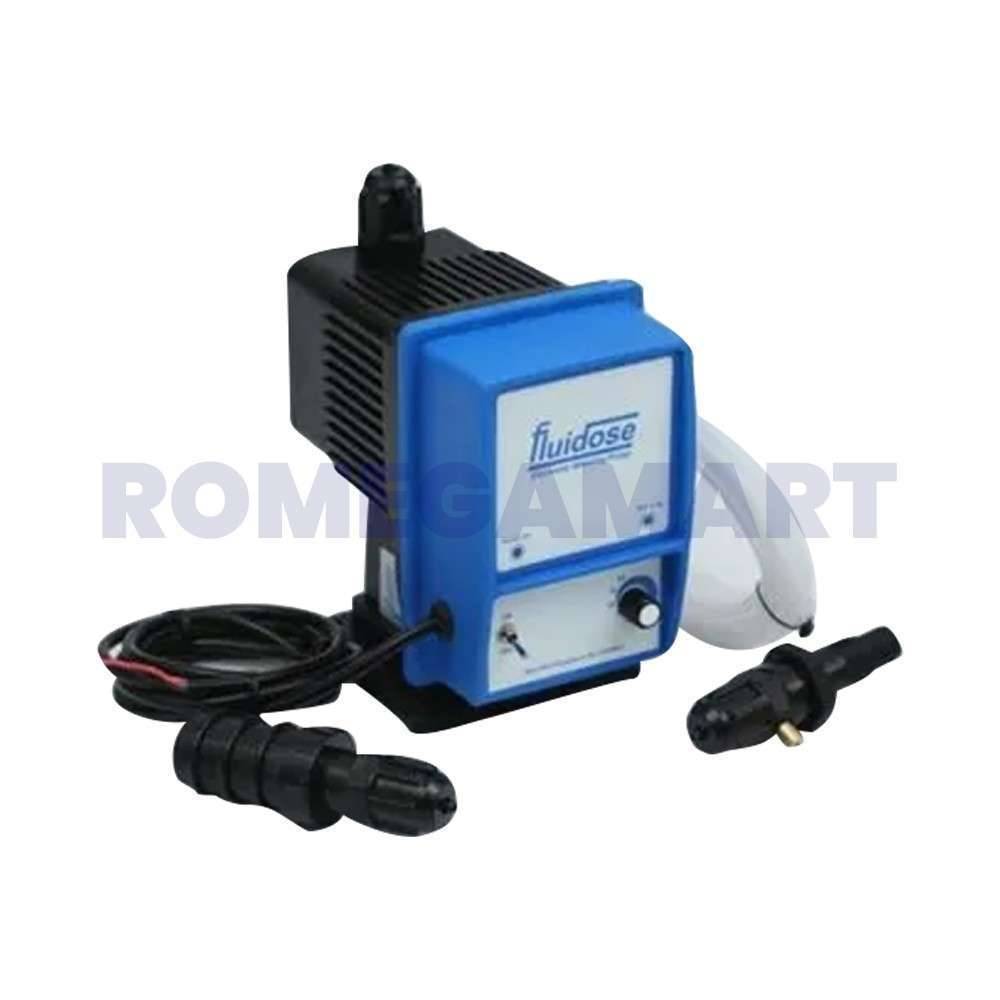What Is a Dosing Pump?
A dosing pump, also called a metering pump or chemical dosing pump, is a precision device designed to inject (or dose) a controlled amount of chemicals or other chemicals into a fluid stream over time. Unlike regular pumps, dosing pumps deliver very small, accurate volumes relative to the flow they are mixing into — and they do this reliably and repeatedly.
In engineering, dosing is a general term for feeding small quantities of chemicals or agents into a system. In water treatment, dosing pumps are vital for metering chemicals like anti-scalants, chlorine, acids, pH adjusters, coagulants, or biocides.
Why Use a Chemical Dosing Pump?
To understand why dosing pumps are important, it's helpful to look at common challenges in water treatment, especially in reverse osmosis (RO) systems or large water treatment plants:
-
Precision: If you underdose, the chemical might not be effective (for example, not enough anti-scalant will lead to scaling on RO membranes). If you over-dose, you risk chemical waste, corrosion, or even damaging downstream equipment.
-
Protection: In RO plants, dosing pumps are used to feed anti-scalant or cleaning chemicals to protect membranes. Without precise chemical dosing, membrane life can drastically shorten.
-
Automation and Control: Modern dosing pumps can be electronically controlled (frequency, pulse input, 4-20 mA, timer-controlled), allowing integration into automated plant control systems.
-
Safety: Controlled dosing reduces the risk of human error. Chemicals like acids or biocides, if overdosed, can be hazardous.
-
Cost Efficiency: Properly sized dosing pumps minimize chemical consumption and therefore ongoing cost, while ensuring effectiveness.
How Does a Dosing Pump Work?
To grasp dosing pump working, let’s break down the core principle and common types:
Basic Operating Principle
Most dosing pumps are positive displacement pumps — meaning they trap a fixed volume of liquid in a chamber and then displace it to the output. This ensures that for each pump “stroke” (or cycle), a known volume is delivered.
One very common type is the diaphragm dosing pump. Here’s how it works:
-
An electromagnetic or solenoid mechanism moves a flexible diaphragm back and forth.
-
On the intake stroke, the diaphragm retracts, creating suction; chemical is drawn into the pump head.
-
On the discharge stroke, the diaphragm pushes forward, forcing the chemical out.
-
Non-return valves (inlet and outlet) ensure flow in the correct direction.
Some pumps allow stroke length or stroke frequency to be adjusted, which changes how much fluid gets pumped per unit time.
In more advanced systems, pulse-width modulation (PWM) or neural network-based controllers have been used to regulate the dosing more precisely. For example, a research paper showed an intelligent feed-forward controller using PWM to control the alum dosing for water treatment.
Types of Dosing Pumps & Their Applications
Different kinds of dosing pumps exist, suited to various use cases. Below are some common types and where they’re used.
-
Diaphragm (Solenoid) Metering Pumps
-
Very common in water treatment, especially for RO systems.
-
Good for low-to-medium flow rates, moderate pressures.
-
Used for anti-scalant, acid/alkali dosing, chlorine, etc.
-
-
Peristaltic Dosing Pumps
-
Use a flexible tube, squeezed by rollers in a rotating mechanism.
-
Excellent for shear-sensitive fluids or aggressive chemicals.
-
Good for applications where contamination must be avoided, because the fluid only touches the tubing.
-
-
Motor-Driven or Plunger Metering Pumps
-
For higher flow rates and higher pressure needs.
-
Often used in large industrial water-treatment plants or chemical processing plants.
-
-
Digital / Electronic / PLC-Controlled Dosing Pumps
-
Stroke frequency or stroke length is controlled electronically (e.g., via 4–20 mA, programmable timer, or pulse input).
-
Provides better precision, remote control, and integration into SCADA or control systems.
-
Dosing Pump Use Cases
Here are several real-world dosing pump use scenarios:
-
RO Plant Protection:
In an RO system, dosing pumps inject anti-scalant to prevent scaling on membranes, acid to adjust pH, or cleaning chemicals during CIP (cleaning in place). -
Water Treatment Plants (ETP/STP):
Dosing pumps are used for adding coagulants, flocculants, biocides, and pH control agents. -
Swimming Pools / Cooling Towers:
Precise chlorine dosing helps maintain hygienic levels without over-chlorination. -
Agriculture / Fertigation:
Dosing pumps mix fertilizer concentrate into irrigation water. -
Industrial Processes:
For accurate chemical addition in operations like paper manufacturing, chemical production, or boiler feed systems.
Dosing Pump in RO Plants: Why It Matters & How Much It Costs
When talking about dosing pump for RO, the stakes are high. RO membranes are expensive, and their performance is sensitive to scaling, fouling, and chemical exposure. Here’s how dosing pumps come into play:
-
Anti-Scalant Injection: Prevent scale buildup (calcium, magnesium, silica) on the membranes.
-
pH Correction: Use acid or alkali dosing to optimize feed-water chemistry.
-
Disinfection / Biocide Dosing: To prevent bio-fouling.
-
CIP (Cleaning): Stronger acid or base chemicals are injected for periodic cleaning.
Dosing Pump for RO Price / RO Plant Dosing Pump Price
Pricing depends on many factors: flow rate (LPH), pressure, material (PP/PVDF/316SS), control type (manual, frequency, digital), and brand. Here are some indicative figures from the Indian market:
-
Pro Aqua RO dosing pump (6 LPH) → ~ ₹2,600 / piece.
-
IPC Pumps Fluxmax 6 LPH dosing pump → ~ ₹4,500.
-
E-Dose 6 LPH dosing pump by OceanRO → ~ ₹5,900.
-
Mini Dose (MED-05) 6 LPH → ~ ₹3,200.
-
Everest dosing pump (up to 15 LPH) → ~ ₹8,800.
Also, on RomegaMart, you can find industrial dosing pumps.
And here is a relevant product listing: [RomegaMart Industrial Dosing Pump page] (the link you requested):
Industrial Dosing Pump
Dosing Pump HSN Code
For import, tax, or GST classification, it’s useful to know the HSN code (Harmonised System of Nomenclature) for dosing pumps. While there's no single universal HSN for all dosing pumps (it depends on the specific device, motor, application), many dosing/metring pumps may fall under “Pumps for liquids” category in HSN. For custom or regulatory clarity, it’s important to check the current tariff classification with the Indian customs or GST guidelines, or consult a tax advisor.
Key Specifications to Consider When Selecting a Dosing Pump
When selecting a dosing pump, these are critical parameters to evaluate:
-
Flow Rate (LPH): How much chemical per hour you need to inject.
-
Maximum Pressure (Head): The pressure it can discharge to.
-
Material of Construction: For chemical compatibility (PP, PVC, PVDF, Stainless Steel).
-
Control Mechanism: Manual stroke adjust, frequency (strokes per min), digital input, 4-20 mA, pulse input, timer.
-
Power Supply: Voltage (e.g., 230V AC) or DC.
-
Diaphragm Type / Seals: For durability and chemical resistance.
-
Mounting / Enclosure: Wall mount, base mount, IP rating, splash-proof enclosures.
-
Valves: Quality of non-return valves (inlet/outlet) affects accuracy.
-
Safety Features: Leak detection, air-release valve, auto-reset fuse, etc.
-
Warranty / After-Sales Support: Important for long-term system reliability.
Dosing Pump Manufacturers in India
There are several well-known manufacturers and suppliers in India that produce dosing pumps for RO or water treatment plants. Here are some:
-
Pro Aqua / Pure & Cure Technology (Ahmedabad): They make chemical RO dosing pumps (1.5, 3.0, 6 LPH).
-
Aqua Safe Plus (Chennai): They provide a 6 LPH @ 4 kg/cm² dosing pump.
-
DosingPump.co.in (New Delhi): They offer various diaphragm dosing pumps; e.g., 6 LPH model, 10 LPH chlorine pump.
-
OceanRO / E-Dose (Ahmedabad): Known for their E Dose 6 LPH dosing pump.
-
Aqua RO Technology (Davanagere): They make 50W dosing pumps (~₹5,000).
-
Varuna Water Care (Madurai): They supply electronic dosing pumps for water treatment.
These companies serve both domestic RO systems and larger water-treatment plants.
Common Challenges in Using Dosing Pumps & How to Solve Them
Using chemical dosing pumps is not entirely plug-and-play — there are practical challenges. Below are some common ones, and recommended mitigations:
-
Air Entrapment:
-
Problem: Air bubbles in the chemical line can reduce dosing accuracy.
-
Solution: Use air-release valves, bleed the line, or prime the pump properly.
-
-
Chemical Compatibility:
-
Problem: If the pumped chemical is aggressive (acid, oxidiser), a wrong material pump head (e.g., regular plastic) may degrade.
-
Solution: Use compatible materials (PVDF, PTFE, SS) for the pump head, diaphragm, and valves.
-
-
Blockage / Crystallization:
-
Problem: Some chemicals (like anti-scalants) may crystallize, especially if concentration or temperature is wrong.
-
Solution: Use proper dilution, regular maintenance, or flushing.
-
-
Control Issues:
-
Problem: Over- or under-dosing due to wrong frequency or stroke settings.
-
Solution: Calibrate the pump, use digital control or feedback (4-20 mA), or integrate with plant automation.
-
-
Leakages:
-
Problem: Chemical leaks can be dangerous and cause waste.
-
Solution: Use good quality check valves, maintain diaphragm integrity, and check seals regularly.
-
-
Power Failures:
-
Problem: If the pump loses power, dosing stops, which can harm RO membranes or water treatment balance.
-
Solution: Use backup power or alarms to detect pump failure.
-
Why the Dosing Pump is Critical to Water-Treatment Plant Health
In a water-treatment plant (or RO plant), the dosing pump is not a “nice to have” — it is mission-critical for several reasons:
-
Membrane Protection: In RO, anti-scalant injection prevents scale formation, which is one of the biggest enemies of membrane efficiency and lifespan.
-
Process Stability: Proper chemical dosing ensures consistent water quality (pH, turbidity, residual disinfectant).
-
Regulatory Compliance: Many water-treatment applications require chemical dosing to meet safety or discharge norms.
-
Cost Efficiency: Chemical overdosing is costly; underdosing can lead to poor treatment. An accurate dosing pump ensures optimal chemical use.
-
Automation & Monitoring: Dosing pumps integrated with control systems help operators track chemical usage, detect faults, and optimize performance.
Dosing Pump 6 LPH Price (and Other Flow-Rate Variants)
The 6 LPH dosing pump is very common in RO and water treatment plants, because it aligns well with typical chemical concentrations and dosing needs. Here are price insights (India):
-
Aqua Safe Plus: 6 LPH @ 4 kg/cm² → ~ ₹4,500.
-
Pro Aqua: 6 LPH dosing rate options → ~ ₹2,600.
-
IPC Pumps (Fluxmax): 6 LPH, 230 V → ~ ₹4,500.
-
OceanRO (E Dose 6 LPH) → ~ ₹5,900.
Higher flow pumps, or pumps made of more resistant materials, will cost more. For example, a 15–20 LPH pump (Everest) is ~ ₹8,800.
Global / Online Market: Example Dosing Pumps You Can Buy
Here are some sample dosing pumps available online, showing the variety and price points:
Edose Dosing Pump
Commercial RO
₹4,050
Bioway Liquid Chemical Dosing Pump
Industrial / Water Plant
₹4,617
12 V Peristaltic Dosing Pump
Peristaltic Low Power
₹533
Robocraze DC 12 V 5000 RPM Pump
High RPM Compact
₹850
12 V DC Peristaltic Dosing Pump
Low‑power Peristaltic
₹594
Robocraze 6 V Mini Dosing Pump
Battery / Low‑Voltage
₹599
Here are a few to highlight:
-
Edose Original Dosing Pump for RO: Specifically made for RO water purifiers; reliable and widely used in commercial systems.
-
Bioway Liquid Chemical Dosing Pump: Designed for commercial and industrial water plants.
-
12 V Peristaltic Dosing Pump: Low-power, portable, and suitable for non-aggressive chemical dosing.
-
Robocraze DC 12 V 5000 RPM Dosing Pump: High-speed, suitable for applications with small, precise bursts.
These show that dosing pumps are available at various scales — from compact, low-power peristaltic ones to more robust, industrial-grade models.
Dosing Pump Motor & Power Considerations
When you mention dosing pump motor, you’re usually referring to the drive mechanism (solenoid or electromagnetic) or the motor driving a plunger or peristaltic mechanism.
-
Solenoid / Electromagnetic Diaphragm Pumps: Common in dosing applications; simple, reliable, and accurate.
-
Electric Motors (DC or AC): Used when peristaltic or plunger designs are employed. For example, low-voltage DC (12 V) motors are used for peristaltic pumps.
-
Power Consumption: Dosing pumps meant for water treatment are often low-power; e.g., 50 W dosing pump variants.
-
Drive Control: You might also find models with variable stroke frequency, which requires electronics to control the motor or solenoid.
Dosing Pump edose / E-Dose Models
“E Dose” (or “edose”) is a brand or sub-brand used by some Indian manufacturers. For example:
-
E Dose 6 LPH dosing pump (by IPC Pumps) → ~ ₹4,800.
-
OceanRO’s E Dose 6 LPH model → ~ ₹5,900.
These pumps are specifically designed for water-treatment applications like RO plants. Their popularity arises from a good balance of performance, precision, and affordability.
Dosing Pump for Water Treatment Plant (Large-Scale Use)
In a large water treatment plant (e.g., ETP, STP, or municipal plant), dosing pumps are used for:
-
Coagulant dosing (alum, PAC)
-
pH control (acid / alkali)
-
Disinfection (chlorine, peroxides, etc.)
-
Polymer dosing for flocculation
-
Anti-scalant dosing before advanced filtration
When scaling up, the following become more important:
-
Reliability: Long service intervals, robust materials.
-
Control & Automation: Integration with SCADA, PLCs, feedback loops.
-
Redundancy: Often two pumps (standby) so that dosing continues if one fails.
-
Safety: Chemical handling protocols, leak detection, alarms.
-
Maintenance: Easy to service valves, diaphragms, and check parts.
Large dosing systems may use multiple dosing pumps of different capacities, depending on chemical feed points.
Market Trends & Manufacturing in India
-
There is a strong base of domestic dosing pump manufacturers in India, as noted earlier (Pro Aqua, IPC Pumps, OceanRO, etc.).
-
Given India’s growing water-treatment infrastructure (municipal plants, industrial wastewater treatment, RO bottling plants), demand for dosing pumps is rising.
-
Local manufacturing helps keep costs competitive, compared to importing dosing pumps from abroad.
-
Indian manufacturers also provide service and spare parts more easily (diaphragms, valves), which is crucial for long-term operations.
How to Select the Right Dosing Pump
Here’s a step-by-step guide / checklist for choosing a dosing pump for your application (especially in RO or water treatment):
-
Define Chemical & Concentration
-
What chemical are you dosing (e.g., anti-scalant, acid, chlorine)?
-
What is the concentration (strength) of the chemical solution?
-
-
Determine Required Flow Rate (LPH)
-
Calculate or estimate the volume of chemical needed per hour, based on plant size, flow rate, and target concentration.
-
-
Estimate Pressure / Head
-
What is the discharge pressure requirement (e.g., injection point pressure)?
-
Is there back-pressure in the line?
-
-
Choose Material
-
Based on chemical compatibility: PP, PVDF, PVC, or SS.
-
Check diaphragm material and valve construction.
-
-
Decide Control Mode
-
Manual stroke adjustment vs. adjustable frequency vs. digital control.
-
Do you need remote control or monitoring (PLC / SCADA)?
-
-
Power Supply
-
AC mains (230 V) vs. DC (12 V or 24 V).
-
Do you have reliable power supply at the dosing point?
-
-
Safety & Maintenance Features
-
Air release valve, auto reset fuse, leak detection.
-
Ease of replacing diaphragm, valves, tubing.
-
-
Cost & Vendor Support
-
Get quotations from vendors with maintenance support.
-
Check warranty, spare parts availability, and service network.
-
-
Redundancy / Backup
-
For critical applications, plan for spare dosing pump or at least a redundant part.
-
-
Commissioning & Calibration
-
Calibrate the pump after installation to ensure correct dosing.
-
Use flow testing or chemical analysis to validate dosing accuracy.
Future Innovations & Trends
-
Smart Dosing Pumps: Integration of IoT sensors, flow monitoring, and remote control.
-
AI / Neural Controllers: Using AI to adapt dosing in real-time based on water quality feedback (turbidity, conductivity, pH). (This is already being researched; see PWM + neural control.)
-
Improved Materials: More chemically resistant materials (advanced polymers) to handle aggressive chemicals.
-
Energy Efficiency: Lower power consumption drives, more efficient designs.
-
Plug-and-Play Modular Systems: Prefabricated dosing skids with multiple pumps, controllers, and safety features for easy deployment.
Conclusion
Dosing pumps are crucial components in water treatment systems — especially in RO plants. Their role in precisely metering chemical addition ensures system protection, process stability, and cost-effectiveness. Whether you are looking for a small 6 LPH E-Dose pump for an RO purifier or a high-precision metering pump for a large water treatment plant, understanding the working principle, specifications, and market dynamics is essential.
Key takeaways:
-
Chemical dosing pump = precision metering device.
-
Dosing pump working is based on positive displacement (often diaphragm).
-
Dosing pump HSN code must be verified for import / GST classification.
-
Dosing pump use spans RO protection, pH control, disinfection, and more.
-
Dosing pump for RO price in India typically ranges (for 6 LPH) from ₹2,600 to ₹6,000+ depending on model & material.
-
Chemical dosing pump for RO is very common and widely manufactured in India.
-
RO plant dosing pump price depends on flow, head, control, and build.
-
The dosing pump for water treatment plant needs to be reliable, often automated, and possibly redundant.
-
Dosing Pump 6 LPH price is a frequently referenced model in Indian RO applications.
-
Dosing Pump manufacturers in India are numerous (Pro Aqua, IPC Pumps, OceanRO, etc.).
-
Dosing pump edose / E-Dose is a popular brand/model in Indian RO applications.
-
Dosing pump motor types vary (solenoid, AC/DC motor, etc.) depending on design.
For procurement, you can check the RomegaMart link you gave: (Explore The Wide Collection Of Industrial Dosing Pump) — they have a range of industrial dosing pumps ideal for water-treatment use.












